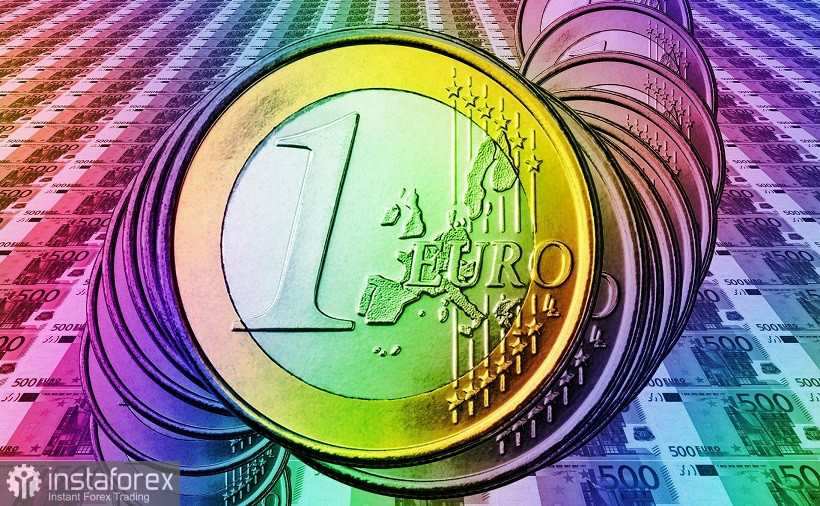The euro-dollar pair continues to trade in the range, narrowing its scope to 1.1260-1.1360. Buyers of EUR/USD could not gain a foothold above the target of 1.1350 on Wednesday, while sellers cannot gain a foothold in the area of the 12th figure. Abstracting from intraday short-term impulses (both up and down), we can come to the conclusion that the pair is standing still, waiting for powerful information drivers.
The issue of divergence of the positions of the ECB and the Fed is on the agenda again, only now this fundamental factor does not play against the single currency. At least for today, the discussion about the prospects of the monetary policy of the European Central Bank helps the euro to stay "afloat." Rumors that the European regulator will follow the example of the Fed and change its position regarding the record growth of inflation in the eurozone are increasingly being heard in the market.

However, there is no official information about this: traders make their assumptions without any fundamental basis. On the side of EUR/USD buyers, there are only some ECB members who doubted that the increase in inflation in the eurozone is temporary (among them - the head of the Central Bank of Estonia and the chairman of the Central Bank of Austria).
Representatives of the "hawk wing" suggest not to expand the scope of the traditional incentive program APP after the end of the pandemic emergency purchase program (PEPP). In fact, the whole "hawkishness" is limited to this proposal. None of the ECB members allows (at least in the public plane) the option of raising the interest rate next year or the option of early curtailment of the PEPP program.
Moreover, even the aforementioned proposal of the ECB hawks was perceived "with hostility" by their conservative colleagues. And according to Reuters, the hawks were forced to retreat before the onslaught of the "dovish" majority.
According to insider information, on the eve of the December meeting of the European Central Bank, a certain compromise was reached. So, according to representatives of the "dovish" wing of the Central Bank, if the regulator does not increase the size of the traditional APP (after the completion of the PEPP), there will be a surge of turbulence in the markets. Therefore, they still propose to expand this program, but at the same time stipulate in advance and set the limits of such an increase—both in the context of sizes and in the context of maximum deadlines.
In addition, according to Reuters, ECB members can increase the volume of asset purchases under the APP program "with an open completion date." Also, the option of launching a new incentive program is not excluded. However, the latter two options, according to insiders, are "extremely unlikely." At the same time, reporters' sources assured journalists that the volume of buying bonds from April next year will be "significantly less" than the current total volume of the APP and PEPP.
After the publication of this insider information, the EUR/USD pair shot up, reaching a local maximum of 1.1355 on Wednesday. Indirect support for the euro was also provided by German journalists: several German publications almost simultaneously published materials criticizing Christine Lagarde.
One of the observers noted that the head of the ECB "does anything but direct duties." According to the journalist, Lagarde is voicing her position on the situation with the environment, and on the problems of gender inequality, and so on, and so on, "while inflation in Europe is breaking all imaginable and unthinkable records."
It is worth noting that inflation in the eurozone has indeed reached a historic high, having been marked at 4.9%. The strongest CPI growth was recorded in all major economies of the European Union. In particular, in Germany, inflation rose to a 29-year high (6% year-on-year), in France, the indicator broke a 13-year record, rising to 3.4%.
Given this fact, the probability of tightening the rhetoric of the accompanying ECB statement following the December meeting is quite high. But can the above intentions of the ECB be regarded as a step towards tightening the parameters of monetary policy? And even more so when compared with the intentions of the Federal Reserve?
Note that next week, the American regulator should curb the pace of QE curtailment from the current $15 billion to $30 billion monthly. It is also possible that Jerome Powell will hint at a possible rate hike next year. Moreover, many representatives of the Fed (Bullard, Mester, Daly, Bostic) have previously stated that the rate could be raised twice in 2022. Many currency strategists and experts of the world's largest banks also agree with them.
All this suggests that the divergence of the positions of the European Central Bank and the Federal Reserve will continue to play on the side of the U.S. currency. The euro received only a temporary respite due to rumors that the ECB will "tighten" its rhetoric at the December meeting. But the de facto European regulator will continue to "hold the line" by implementing an accommodative policy. The uncorrelation of the positions of the Fed and the ECB will not go away, even if the European regulator implements the above intentions.
Thus, if we talk about long-term prospects, the priority remains with the greenback. However, before the announcement of the verdicts of the Fed and the ECB (December 15 and 16, respectively), the pair will fluctuate in the 100-point range against the background of general uncertainty, numerous rumors, and speculation. Therefore, with the attenuation of the downside impulse in the area of 1.1260, purchases can be considered, and, accordingly, with the attenuation of the upside impulse in the area of 1.1360, it is advisable to go into sales.





















